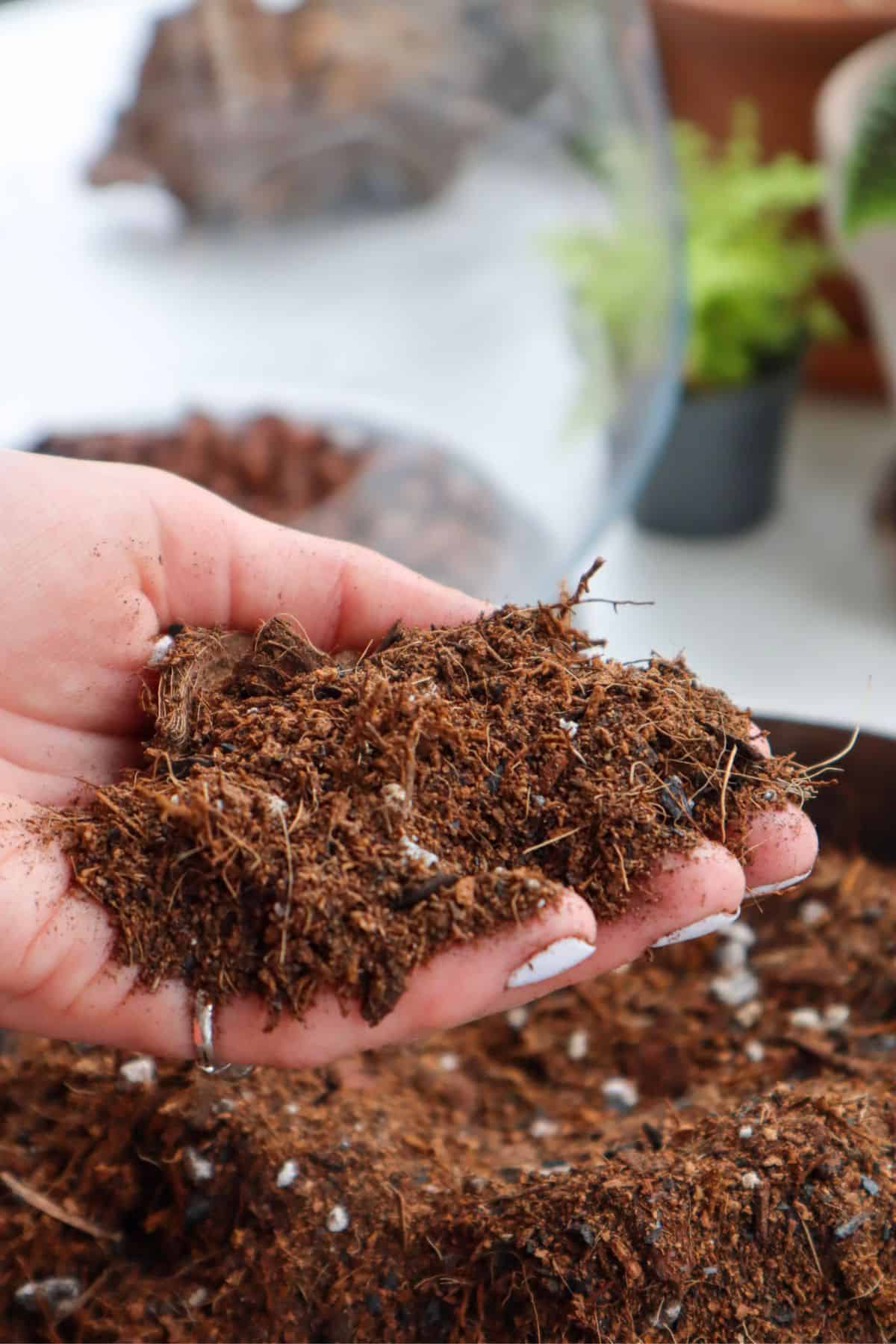Pteris ensiformis ‘Evergemiensis’ is an elegant little variegated Brake Fern that’s sure to delight.
Often called the Silver Lace Fern for its silvery-white foliage and bright venation, its feathery fronds grow right across the length of its long arching stems.
Honestly, it’s quite the mix of soft and sharp textures.
Despite its tropical origins in Southeast Asia and China, it actually gives off more of a woodland vibe. But it’s those roots (pun intended) that make it such a great terrarium plant.
Find out how to care for Pteris ensiformis and keep its foliage looking pristine.

Where to Buy the Silver Lace Fern
See the links below to purchase from reputable terrarium plant shops and marketplaces (may include affiliate links).
Silver Lace Fern Care & Growth
| Plant Type | Fern |
| Lighting | Medium – high indirect light |
| Temperature | 65-80°F (18-26°C) |
| Watering | Regular, even moisture |
| Humidity | High humidity (60-90%) |
| Growth | 10-20 inches |
Lighting
As with most tropical ferns, the Silver Lace Fern is used to growing under dappled rainforest lighting.
In the home, you’re going to want to provide bright indirect light. Either in the form of filtered sunlight (e.g., through blinds) or through positioning far enough away from a light source.
The creamy white variegated parts of the plant actually can’t photosynthesize, so it’s worth trying to achieve the most light possible in as safe a way as possible.

Unfortunately, these delicate fronds can burn under direct light, so that’s a no-go.
When it comes to terrariums, by far, the easiest way is to simply run with a grow-light solution. That way, you can maximize those lighting conditions without any risk of harming the plant.
How to Water
Pteris ensiformis ‘Evergemiensis’ likes consistent even moisture to thrive and will quickly degenerate if allowed to dry out.
The fern is capable of looking quite flush with rounded edges, but if it’s lacking in moisture, it can quickly turn into a raggedy-looking thing.
Unfortunately, our plant arrived closer to the latter state, but there’s hope yet.
Naturally, it should be very at home in a moist tropical terrarium environment – so that’s where we put ours!

Substrate / Soil
To keep this slender Brake Fern happy, try a nutrient-rich substrate that effectively retains moisture and drains well. Any solid tropical mix should do the job nicely.
Organic mixes containing bark, sphagnum moss, coconut coir, and earthworm castings are all good here.
If in doubt, I tend to start with the classic ABG mix as a template and adjust where necessary.
👉 If in doubt, our tropical substrate mix is a well-balanced option.

Temperature & Humidity
Growing best in tropical and subtropical environments, Pteris ensiformis ‘Evergemiensis’ will truly thrive under warm and humid conditions.

All that said, it’s actually a reasonably hardy fern and is somewhat forgiving on the temperature front. So, I wouldn’t worry too much about it struggling in the Winter months.
Humidity is more important, however. If your home is pretty dry, you could try grouping plants (which is a great excuse to buy more as far as I’m concerned), or, of course, plant it in a closed terrarium.
Growth
Outdoors, the silver lace fern can grow up to 35 inches high, but in a terrarium, it’s likely to stay in its much smaller juvenile form.
That being said, this fern does have a very upright growth habit. So they might reach the top of your terrarium and need a trim every so often.

For some reason, there’s always one stem that’s different (different foliage, too) and tends to grow much taller than the rest. Weird.
Here’s a mature Silver Lace Fern we found in a garden shop for comparison.

How to Propagate the Silver Lace Fern
The easiest way to propagate Pteris ensiformis ‘Evergemiensis’ is through division.
You can gently tease apart the roots to form new plants in whatever size you need. Provided each has at least one healthy stem and front, it has a good chance of becoming a viable plant.
If it’s being stubborn and you find you can’t separate it with your fingers alone, enlist the help of some scissors to snip through any tough material.

It’s honestly pretty essential if you’re going to be planting up a terrarium with a narrow opening.
Common Problems
The biggest thing to look out for when caring for the Silver Lace Fern is its watering.
It has fairly high water requirements, and it’s susceptible to drying out. If you see any signs of brown edges or drooping fronds, you need to add more water.

I’d also consider using a plastic pot instead of a terracotta pot in the home. Terracotta wicks away moisture so fast it can be hard to keep replacing it. I’ve learned the hard way with a few of my ferns.
Varieties & Similar Plants
There are almost 300 species in the Pteris genus, and a few of them are commonly used in terrariums.
If you want some ribbon to match your lace, Pteris cretica (Silver Ribbon Fern) is a lovely choice and undoubtedly the most commonly available alternative.
Pteris dentata ‘stramina’, and Pteris quadriaurita ‘Tricolor’ are both contenders too.

